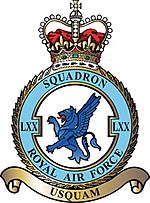|
No. 70 Squadron RAF
No. 70 or LXX Squadron[a] RAF operates the Airbus A400M Atlas C.1, to provide strategic air transport worldwide. It is based at RAF Brize Norton.[2] HistoryFirst World WarThe squadron was formed on 22 April 1916 at Farnborough, and was equipped with the Sopwith 1½ Strutter. The squadron was posted to France, and in 1917 re-equipped with Sopwith Camels.[3]  During the First World War, the squadron claimed 287 victories, and had as members nineteen aces, including Frank Granger Quigley, John Todd, Frank Hobson, Oscar Heron, Frank Gorringe, Walter M. Carlaw, George Robert Howsam, Clive Franklyn Collett, Alfred Michael Koch, Kenneth Bowman Watson, Noel Webb, Edward Gribben, and Frederic Laurence.[4] Inter-war yearsThe squadron briefly disbanded in January 1920, reforming nine days later at Heliopolis, Egypt, by the renumbering of No. 58 Squadron. The squadron was now a bomber-transport unit operating the Vickers Vimy bomber. After transferring to RAF Hinaidi, Iraq in December 1921, the squadron was re-equipped with Vickers Vernons and subsequently by Vickers Victoria in 1926. In addition to providing heavy transport facilities to both air and ground units they were used as air ambulances and were responsible for maintaining the Cairo-Baghdad airmail route.[5] The squadron was commanded by Group Captain Eric Murray DSO MC. In 1929, he flew the first route to the Cape on behalf of Imperial Airways who were seeking routes for the civil flights.[6] In December 1928, a coup against the Amir of Afghanistan by Habibullah Kalakani supported by Ghilzai peoples led to the first large scale air evacuation, the Kabul Airlift. Over two months Victoria troop-carriers of 70 squadron played central role in the airlift of 586 British and European officials and civilians flying over mountains at a height of up to 10,000 feet (3,000 m) often in severe weather.[7]  The Vickers Valentia replaced the Victorias in November 1934. 70 squadron is recorded as being based at RAF Habbaniya from 1937–9 and in August 1939, it returned to Egypt.[8] Second World WarAt the outbreak of war in September 1939, No. 70 squadron had just moved to RAF Helwan, in a suburb of Cairo, Egypt. Italy entered the war on 10 June 1940, and on that date the squadron switched to RAF Heliopolis, still in Cairo, and still flying the obsolescent Valentia transport aircraft. On 1 September 1940 the role of the squadron changed when they started to receive modern equipment in the shape of six Vickers Wellington bombers. Later that month they undertook the first bombing mission, beginning operations with an attack on targets in the Dodecanese Islands (Greece).[8][9]  In 1940 A detachment was sent to Tatoi Airport, just north of Athens, in support of Allied forces defending Greece and in 1941 the squadron was involved in the campaign to conquer Vichy-occupied Syria and the Rashid Ali rebellion in Iraq.[10] 70 Squadron relocated frequently in support of the 8th Army's westward advance, first into Libya then Tunisia. In November 1943 it relocated to Djedeida 20 miles west of Tunis, putting industrial targets in the North of Italy within easy reach. Between December 1943 and October 1945 the squadron relocated to Tortorella Airfield, Italy where the Wellingtons were replaced by the long range Liberators.[10] Post Second World War The squadron disbanded in April 1947 and was reformed in May 1948, at RAF Kabrit, Egypt when No. 215 Squadron was renumbered No. 70 Squadron. The squadron was equipped with Douglas Dakotas until 1950, when it re-equipped with Vickers Valettas. In 1955, the squadron moved to RAF Nicosia, Cyprus and re-equipped with the Handley Page Hastings, Vickers Valetta and later used the Percival Pembroke twin engined communication aircraft. In 1966 the squadron moved to RAF Akrotiri. While there they won the Lord Trophy at RAF El Adem in competition with five other medium range transport squadrons. After a brief period operating Armstrong Whitworth Argosy C.1s, the squadron began conversion to the Lockheed C-130 Hercules in 1970, and moved to RAF Lyneham in 1975, after 55 years overseas. After 35 years of operating the Hercules C1/C3 from Lyneham, the squadron disbanded in September 2010.[11]  The squadron reformed on 1 October 2014 and was officially "stood up" on 24 July 2015 by presentation with a new standard by Princess Anne[12] becoming the Royal Air Force's first frontline A400M squadron.[13] In 2017 the squadron was part of Op Ruman, the humanitarian aid relief after Hurricane Irma.[14] In August 2021, the squadron was deployed forward Al Minhad Air Base in Dubai, United Arab Emirates, sending two aircraft to assist with Operation Pitting. This was the largest Royal Air Force airlift since the Berlin Airlift,[15] helping to evacuate British Nationals and vulnerable Afghanis from Kabul Airport.[16][17][18] Battle Honours
* Honours marked with an asterisk may be emblazoned on the Squadron Standard Aircraft operated
See alsoReferences
External linksWikimedia Commons has media related to No. 70 Squadron RAF.
|
||||||||||||||||||||||||||||||||||||||||||||||||||||||||||||||||||||||||||||||||||||||||||||||||||||||||||||||||
